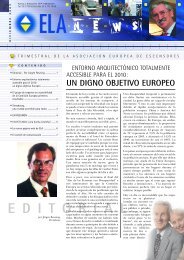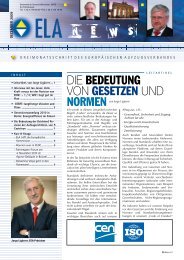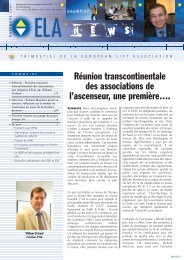WP6-Brochure-E4 brochure - ELA European Lift Association.
WP6-Brochure-E4 brochure - ELA European Lift Association.
WP6-Brochure-E4 brochure - ELA European Lift Association.
You also want an ePaper? Increase the reach of your titles
YUMPU automatically turns print PDFs into web optimized ePapers that Google loves.
21 Interface lift and building: shaft ventilation, smoke clearance, shaft insulation<br />
Ventilation of the lift shaft has two purposes: first, to provide fresh air to the lift shaft and the<br />
cabin, second to remove smoke from the building in case of fire. Ventilation is in the simplest<br />
case, accomplished by a permanently opened hole in the building shell. Therefore, depending<br />
on the configuration, this opening can lead to uncontrolled thermal losses.<br />
As the shaft and its features are a part of the building, lift companies often do not feel<br />
responsible for this issue. However, as this is induced by lift installations, building planners and<br />
constructors do not feel responsible either. As this can lead to considerable losses, this aspect<br />
also needs to be taken into account. Furthermore, shaft walls are heat‐conducting parts of the<br />
building that are often forgotten when the building is insulated [13].<br />
Recommendation: the lift system needs to be closely monitored also regarding its integration<br />
into the building as a whole. Uncontrolled ventilation and losses by heat conduction should be<br />
avoided.<br />
Relevance: all lift installations.<br />
Next to their energy efficiency, the running time and usage of these components are very<br />
important factors for overall energy demand. A list of different operational and organisational<br />
measures to reduce energy consumption can be found in Table 7‐8.<br />
Table 7‐8. Energy efficiency: <strong>Lift</strong> operation<br />
22 Switching off car lighting when not in use<br />
Operation<br />
Some light sources such as modern LEDs can be dimmed and switched off without reducing<br />
their life time (see Chapter 3). Provided that such light sources are installed in a lift, switching<br />
off the car lights when a lift is not in use can lead to significant energy savings (see also [11]).<br />
Sensors may be installed to verify whether a person is in the car. In the case of glass cars,<br />
sensors may also be used to check the lighting provided by external sources and to adjust<br />
lighting accordingly.<br />
Recommendation: switching off car lighting is a very cost‐effective and simple method to<br />
increase energy efficiency.<br />
Relevance: all lift installations.<br />
23 Use automatic car fan control / switch‐off fan<br />
Sometimes, a fan provides fresh air to the car. Independently of its efficiency, it is permanently<br />
using energy when running.<br />
Recommendation: using an automatic control system (e.g. time or temperature controlled) for<br />
operating the car fan, if available, can reduce energy consumption.<br />
Relevance: all lift installations.<br />
112

















